Quang Phu Cau Village, a centre of incense making in Hanoi's suburban district of Ung Hoa has now also resumed the production of the worshipping goods.
The village has been a great source of incense supply for the northern region for many decades, and colourful photos of the village have become iconic around the world. But villagers are now struggling to preserve the more than 100 year craft, which they consider of unique cultural character.
Before the pandemic, the village would be awash with hundreds of brightly coloured incense-stick bunches standing on the roadsides in the sun for drying. They would flash under the sunlight in amazing blazes of red, pink and brown. Now such images have been "disappearing" due to a steep decline in production.
The production halt has significantly affected local business revenue, authority budget contributions and jobs for workers in the village.
Return to work
Since the city eased social distancing curbs, local authorities and villagers have been excited to reopen, vowing to focus again on economic development.
Although craft villagers have been happy to return to work, the recovery of business has faced many difficulties, especially for small-scale workshops which, after a long break due to the pandemic, cannot earn adequate revenue to cover production costs and boost investment.
At the incense workshop of Nguyen Thi Binh in Cau Bau Ward of Quang Phu Cau Commune, eight people have returned to work since the city authorities eased quarantine rules in mid-September.
Their daily work currently just focuses on making and drying incense sticks. All of the workers have had their income affected by the stalled production but now are able to come back to work, hoping to recover the reputation of their products.
According to Binh, the workshop has committed to absolutely complying with the Ministry of Health's anti-pandemic rules.
"Before working, workers are asked to take full measures to prevent and control COVID-19 such as wearing masks, measuring body temperatures, and disinfecting hands," said Binh.
"As workers here are mostly relatives or friends in the village and have been vaccinated with the first dose against COVID-19, they are all excited to come back to work, seeing it as a chance to not only bring them joy but also help them earn more money during the current hard time."
Nguyen Huu Truong, owner of the Anh Truong incense workshop, said: “My workshop specialises in producing sticks for making all kinds of incense. During the pandemic outbreak, we were heavily impacted by interrupted production.”
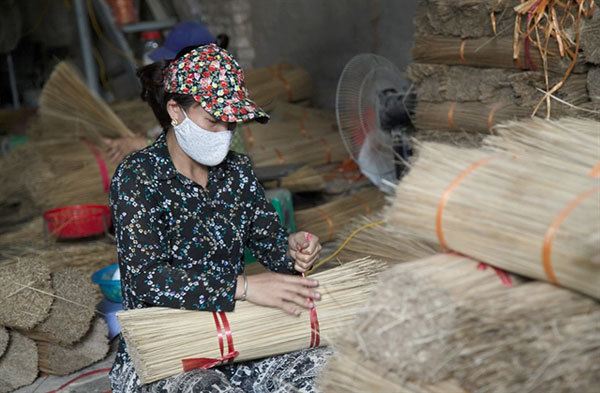 |
| The making of incense sticks is not a hard work. It includes various steps, each one done by hand, including splitting bamboo into thin sticks. -- Photo nhandan.vn |
“Since my unit had to temporarily close, the workers' daily income sharply decreased. Moreover, a dramatic drop in the product price also caused serious hardship for us."
Truong said that despite resuming production, work was not as convenient as before.
"Currently, we are trying our best to gradually overcome difficulties to stabilise operations. Some customers have started ordering and making contracts. This is a really good sign and great encouragement for us,” he said.
According to Nguyen Huu Nhat, chairman of the People's Committee of Quang Phu Cau Commune which is home to the village, at present, the commune has six villages all running incense craft. As they are mainly in the same area, the management is not difficult for local authorities.
Although the communal authorities have loosened curbs on public movement and production activities after a long period of distancing, it currently found it necessary to encourage people to return to work while continue ensuring anti-pandemic rules.
"At incense production facilities, people now are very well-implementing public regulations and directives on COVID-19 prevention and control, especially after the communal People's Committee's announcements about the post-social distancing rules. All production households have actively set up plans to meet the requirements of the Ministry of Health," he said.
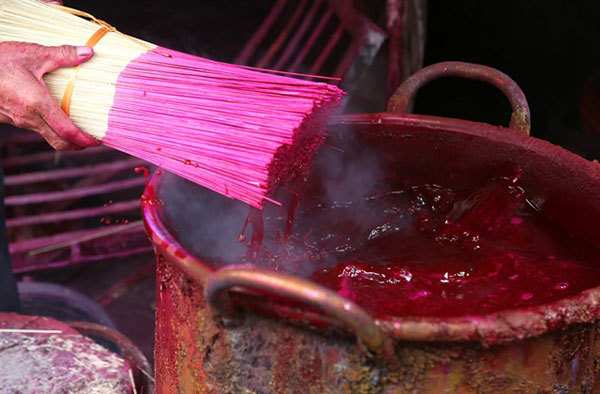 |
| Bamboo sticks are dyed red. -- Photo nhandan.vn |
"The communal People's Committee always creates favourable conditions for local people to boost production, especially after the social distancing so that they can focus more on restoring the local economy, at the same time improve their living standards making a contribution to the district's socio-economic development," the commune chief added.
Historic craft
According to local elders, the craft of making incense has been practised in Quang Phu Cau for over 100 years. It first began in Phu Luong Thuong Hamlet, before expanding to surrounding hamlets.
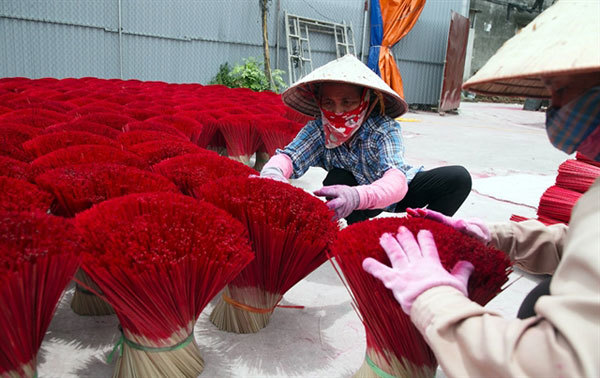 |
| Bunches of incense sticks are dried in the sun. The incense making craft can bring in an income of VND5-6 million a month for each worker. Photo nhandan.vn |
As incense sticks are made from bamboo, the village's workshops need around 200 tonnes of bamboo a day before the pandemic, which are mostly bought from the provinces of Bac Kan, Lang Son, Thai Nguyen and Thanh Hoa.
The making of incense sticks includes various steps, each one done by hand, including splitting bamboo into thin sticks, dyeing them red, letting them dry outdoors, mixing aromatic paste, and rolling the paste around the sticks, and drying them in the sun again.
Before the pandemic, each worker could earn between VND5-6 million (US$215 –258) a month. Those who have more experience can get up to VND8 million.
Quang Phu Cau's incense sticks are not only favoured by domestic customers but also exported to foreign markets around the world.
Source: Vietnam News
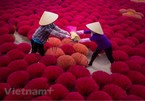
Incense-making Quang Phu Cau village
Quang Phu Cau village in Ung Hoa district, 35 kilometres from downtown of Hanoi, is famous for its century-old craft of making incense.
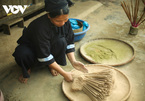
Incense-making craft of Nung ethnic group in Cao Bang
The craft of producing incense practiced by the Nung ethnic minority in the northern province of Cao Bang has been passed down from generation to generation.